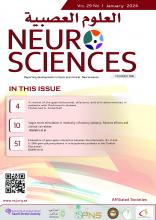Abstract
Objectives: To determine the relationship between hemoglobin A1c (HbA1c) and different types of stroke, and how different comorbidities and risk factors are related to the occurrence of stroke in a Saudi Arabian tertiary care hospital.
Methods: This retrospective study was conducted at King Abdulaziz Medical City, Riyadh, Kingdom of Saudi Arabia. The study included patients who experienced either hemorrhagic stroke (HS), ischemic stroke (IS), or transient ischemic attack (TIA) between 2015 and 2020.
Results: In total, 976 patients were included, of whom 670 were males (68.6%). The incidence of HS was significantly higher in males compared to females (14.2% vs. 6.9%), whereas the incidence of IS was higher in females (76.8% vs. 74.6%) (p=0.001). Ischemic stroke was significantly higher in the 65 years or older age group, whereas HS was comparatively higher among those aged <65 years. The means HbA1c levels in all three types of stroke were abnormally high. However, HbA1c levels were significantly higher in IS than in the other 2 stroke types (p=0.017). The HbA1c levels showed statistically significant differences between the different types of stroke, where the estimated marginal means were higher in patients with IS with a small effect size. Heart disease was also more prevalent in the IS group. Stroke-related mortality was reported in 16 patients and was significantly higher in the IS group than in the HS group.
Conclusion: The HbA1c levels were elevated in all types of stroke, significantly in IS. Controlling patients’ HbA1c and other modifiable risk factors could significantly reduce the risk of stroke.
- Received April 17, 2023.
- Accepted September 19, 2023.
- Copyright: © Neurosciences
Neurosciences is an Open Access journal and articles published are distributed under the terms of the Creative Commons Attribution-NonCommercial License (CC BY-NC). Readers may copy, distribute, and display the work for non-commercial purposes with the proper citation of the original work.






